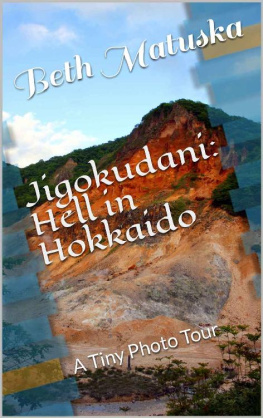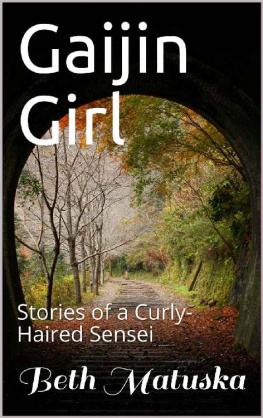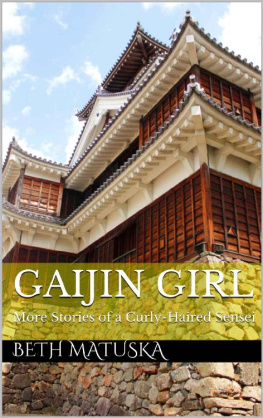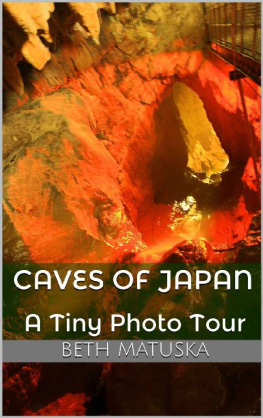Beth Matuska - Jigokudani
Here you can read online Beth Matuska - Jigokudani full text of the book (entire story) in english for free. Download pdf and epub, get meaning, cover and reviews about this ebook. year: 0, genre: Art. Description of the work, (preface) as well as reviews are available. Best literature library LitArk.com created for fans of good reading and offers a wide selection of genres:
Romance novel
Science fiction
Adventure
Detective
Science
History
Home and family
Prose
Art
Politics
Computer
Non-fiction
Religion
Business
Children
Humor
Choose a favorite category and find really read worthwhile books. Enjoy immersion in the world of imagination, feel the emotions of the characters or learn something new for yourself, make an fascinating discovery.
- Book:Jigokudani
- Author:
- Genre:
- Year:0
- Rating:5 / 5
- Favourites:Add to favourites
- Your mark:
- 100
- 1
- 2
- 3
- 4
- 5
Jigokudani: summary, description and annotation
We offer to read an annotation, description, summary or preface (depends on what the author of the book "Jigokudani" wrote himself). If you haven't found the necessary information about the book — write in the comments, we will try to find it.
Jigokudani — read online for free the complete book (whole text) full work
Below is the text of the book, divided by pages. System saving the place of the last page read, allows you to conveniently read the book "Jigokudani" online for free, without having to search again every time where you left off. Put a bookmark, and you can go to the page where you finished reading at any time.
Font size:
Interval:
Bookmark:
Jigokudani: Hell in Hokkaido
A Tiny Photo Tour
Beth Matuska
2017 Beth Matuska
All Rights Reserved. No part of this publication may be reproduced, distributed, or transmitted in any form or by any means, including photocopying, recording, or other electronic or mechanical methods, without the prior written permission of the publisher, except in the case of brief quotations embodied in critical reviews and certain other noncommercial uses permitted by copyright law.
For my wonderful students, who put up with a quirky and odd teacher for so many years.
Introduction
In all my years in Japan, Hokkaido's natural wonders have held my attention the longest. Filled with geological features that I have rarely seen elsewhere, Hokkaido is a place that I could return to over and over, and it would never get old or repetitive. In this first book of my new tiny photo tour series, I will be taking you on a visual tour of one of Hokkaido's most striking locations: Jigokudani, or Hell Valley.
Why Jigokudani? It has unique volcanic features concentrated into a relatively small area. Even those with limited hiking experience and endurance can comfortably hike the area, making it the ideal natural getaway. A bonus is the general lack of foreign tourists, so you are more likely to get an authentic experience, rather than the standard tourist areas you might find in the big cities.
I intend for this to be a more visual experience, as words simply cannot do Jigokudani justice. Rather than simply reading about it, I would like you to truly see it, feel it, in the way that I did, up close and personal. If you get the chance to visit Japan, Jigokudani is worth the detour and the extra day or two necessary to get the most out of your trip. Enjoy!
Getting There
Getting to Jigokudani takes a bit of time and effort. Located in Hokkaido, south and slightly east of Sapporo, the park is off the beaten track for most. If you aren't comfortable driving in Japan, public transportation is a viable alternative. Generally, you are going to want to fly into Sapporo and start from there.
While not as comprehensive as on Honshu, trains in Hokkaido still provide decent access to most regions of the island. From Sapporo, you will need to take the train from JR Sapporo Station to Noboribetsu Station, which is closest to Jigokudani. Fares start from 2,160 yen and go up to 4,480 yen, depending on the speed of the train. Expect a time frame of two to three hours. From Noboribetsu, you have the option of taking a bus or a taxi.
Both the bus and the taxi are decent options for getting around, but if you are on a budget, stick with the bus. The taxi can cost more than 2,000 yen. Costing less than 400 yen for a one-way ticket, the bus is by far the more economical choice, so long as you double-check with the driver as to the destination of the bus. In more rural areas, buses are less likely to have destinations written in English, and it is easy to get on the wrong bus. If your Japanese isn't very good, simply pick up a free pamphlet at the train station and show the driver the picture. Or show a picture from this book. They will understand. The buses only leave once or twice an hour, so be sure to have something for the wait.
On the approach to Jigokudani, you will be greeted by amazingly large statues of oni, or Japanese ogres, which stand tall over the approach. These massive statues are bright red and orange, perhaps hinting at the scorching heat to come.

Intimidating, isn't he? An appropriate guardian at the entrance to the Noboribetsu Hot Springs Resort area. After all, no geothermal wonderland would be complete without a hot spring resort. Before the actual park lies a small area filled with hot spring hotels, shops and parks. A nice, albeit expensive place to spend an evening. As the geothermal activity isn't confined to the park itself, the tiny resort area steams and bubbles with little geysers.
Of course, this oni isn't alone. Throughout the area, smaller oni guard shrines and geysers, entrances, perhaps, to hell? This particular oni guards a small shrine. Not so scary now, is he?

Another oni with an even bigger spiked club guards the entrance to a geyser located just off the main street. Still, given his size relative to his club, I would call him cute as well. He's ready for his bath time, with a towel and a small round cup or bucket that reads Noboribetsu in Hiragana.

The geyser guarded by this oni is so hot that an alcove has been built around it to protect passersby. Steam constantly billows out of it, and boiling water sprays upwards regularly. Though not large or high in comparison with places like Yellowstone National Park, the close proximity is sure to impress. Tourists can walk right up near the geyser, separated by a small fence.

While not as impressive as a geyser left on its own out in the wild, it is still interesting in its own right, and a fun place to take selfies. Just be careful not to let your camera or phone get too wet from the steam! You are going to want to take a bath after spending time in the sulfur-scented steam.
Entering Hell Valley
Jigokudani translates to Hell Valley, and you will see why as soon as you enter. The sulfurous clouds that emanate from the vents throughout the valley, staining the rocks around them, the red rocks that poke out from under a thin layer of green, just around the edges...and, of course, the heat. Everything is reminiscent of a furnace, the heat just barely contained. The valley itself has a harsh kind of beauty, the kind that says, look, don't touch. When you enter, be warned: do not stray off the path. Off of the boardwalk, your safety is highly in doubt. Still, as the path winds through the valley, you get the opportunity to see the power of nature up close.

The center of the valley is full of danger. Craters and vents fill the center, and the path skirts the area, not daring to go farther in. Greenery still fights to survive along the cooler edges, but the center is far too hot.

While this clear-cut channel in amongst the ridges leads into a vent, it is unclear the purpose of the machinery at the edge. The landscape is almost otherworldly in places, more reminiscent of Mars than Earth. Getting that close to a vent would be almost unbearably hot.

Of course, looking out over the valley, it is difficult to see any area that wouldn't be hot. As you walk through the valley, the craters are more exposed and visible, and everywhere you look, steam is seeping out of vents both large and small.

Font size:
Interval:
Bookmark:
Similar books «Jigokudani»
Look at similar books to Jigokudani. We have selected literature similar in name and meaning in the hope of providing readers with more options to find new, interesting, not yet read works.
Discussion, reviews of the book Jigokudani and just readers' own opinions. Leave your comments, write what you think about the work, its meaning or the main characters. Specify what exactly you liked and what you didn't like, and why you think so.













